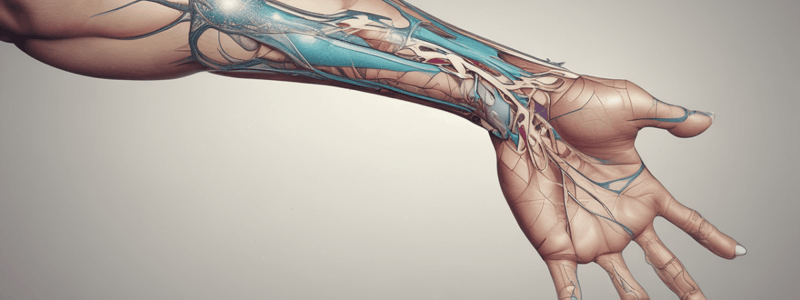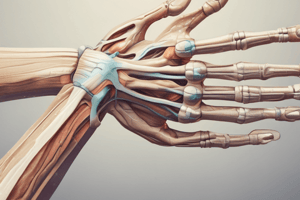Podcast
Questions and Answers
What is a common characteristic between nerve entrapment in the upper extremity and spinal pathologies?
What is a common characteristic between nerve entrapment in the upper extremity and spinal pathologies?
- Compression usually occurs at the entrance and exit locations of the nerves. (correct)
- Only occurs in the upper extremity region.
- Is caused by muscle bellies alone.
- Does not involve ligamentous complexes.
What is a temporary form of mild compression called according to the text?
What is a temporary form of mild compression called according to the text?
- Myelopathy
- Neuropraxia (correct)
- Neuropathy
- Neuritis
Which area is NOT mentioned as a location for compression in the elbow and proximal forearm region?
Which area is NOT mentioned as a location for compression in the elbow and proximal forearm region?
- Cubital tunnel
- Guyon canal
- Median nerve groove (correct)
- Radial tunnel
What is the cause of neuropathic pain and paresthesia symptoms in cases of neuropraxia?
What is the cause of neuropathic pain and paresthesia symptoms in cases of neuropraxia?
What term is used to describe the recovery seen in neuropraxia once the temporary compression is removed?
What term is used to describe the recovery seen in neuropraxia once the temporary compression is removed?
Which type of postures can cause neuropraxia due to mild compression?
Which type of postures can cause neuropraxia due to mild compression?
What is the equivalency of a fifth degree injury according to the text?
What is the equivalency of a fifth degree injury according to the text?
Which types of injuries are mentioned as the most common types of peripheral nerve trauma?
Which types of injuries are mentioned as the most common types of peripheral nerve trauma?
How do world wars contribute to our knowledge of peripheral nerve repair, according to the text?
How do world wars contribute to our knowledge of peripheral nerve repair, according to the text?
Why is understanding the anatomy of trauma emphasized for successful treatment of traumatic peripheral nerve injuries?
Why is understanding the anatomy of trauma emphasized for successful treatment of traumatic peripheral nerve injuries?
What classification is mentioned that assists clinicians and neuroscientists in studying peripheral nerve injuries?
What classification is mentioned that assists clinicians and neuroscientists in studying peripheral nerve injuries?
What classification scheme for peripheral nerve injury was introduced by Sir Herbert Seddon?
What classification scheme for peripheral nerve injury was introduced by Sir Herbert Seddon?
Which nerve injury type is characterized by loss of axonal continuity without disruption of the fascicular connective tissue elements?
Which nerve injury type is characterized by loss of axonal continuity without disruption of the fascicular connective tissue elements?
What is the mildest type of nerve injury according to Seddon's classification?
What is the mildest type of nerve injury according to Seddon's classification?
Which type of nerve injury refers to the most severe injury with compromised sensory and functional recovery?
Which type of nerve injury refers to the most severe injury with compromised sensory and functional recovery?
According to Seddon, what does 'neurapraxia' mean?
According to Seddon, what does 'neurapraxia' mean?
Which researcher further stratified Seddon's three injury types into five categories?
Which researcher further stratified Seddon's three injury types into five categories?
What is the term used to describe a block to conduction of nerve impulses without disruption of the axon or perineurium?
What is the term used to describe a block to conduction of nerve impulses without disruption of the axon or perineurium?
In which situation may corticosteroid injection with local anesthetic be useful according to the text?
In which situation may corticosteroid injection with local anesthetic be useful according to the text?
What plays a key role in the referral to surgical management according to the text?
What plays a key role in the referral to surgical management according to the text?
Which term is used to describe complete transection of a nerve?
Which term is used to describe complete transection of a nerve?
What is the clinical sign characterized by pain on palpation/tapping of the ulnar nerve in cubital tunnel and Guyon's canal?
What is the clinical sign characterized by pain on palpation/tapping of the ulnar nerve in cubital tunnel and Guyon's canal?
Which of the following movements can aggravate pain and paresthesia in cubital and Guyon's tunnel syndrome?
Which of the following movements can aggravate pain and paresthesia in cubital and Guyon's tunnel syndrome?
What is a common clinical symptom in severe cases of ulnar nerve compression?
What is a common clinical symptom in severe cases of ulnar nerve compression?
Which test is performed in cases of mild ulnar nerve compression with only pain as a clinical sign and no sensory/motor deficits?
Which test is performed in cases of mild ulnar nerve compression with only pain as a clinical sign and no sensory/motor deficits?
What is the term for weakness of interosseous and lumbrical muscles leading to muscle imbalance in the hand?
What is the term for weakness of interosseous and lumbrical muscles leading to muscle imbalance in the hand?
What type of splint is recommended to limit elbow flexion during the night in cubital tunnel syndrome?
What type of splint is recommended to limit elbow flexion during the night in cubital tunnel syndrome?
What is a common conservative approach for symptom modification in cubital and Guyon's tunnel syndrome?
What is a common conservative approach for symptom modification in cubital and Guyon's tunnel syndrome?
'Duchenne sign' refers to which specific clinical manifestation related to ulnar nerve compression?
'Duchenne sign' refers to which specific clinical manifestation related to ulnar nerve compression?
What do slowed conduction and/or conduction block at the elbow or wrist indicate in electrodiagnostic studies?
What do slowed conduction and/or conduction block at the elbow or wrist indicate in electrodiagnostic studies?
Flashcards are hidden until you start studying




